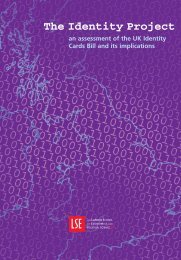Money Laundering: Review of the Reporting ... - Dematerialised ID
Money Laundering: Review of the Reporting ... - Dematerialised ID
Money Laundering: Review of the Reporting ... - Dematerialised ID
Create successful ePaper yourself
Turn your PDF publications into a flip-book with our unique Google optimized e-Paper software.
kpmg<br />
<strong>Review</strong> <strong>of</strong> <strong>the</strong> regime for handling Suspicious Activity Reports<br />
Report <strong>of</strong> recommendations<br />
KPMG LLP<br />
Figure 4.3: Volumes <strong>of</strong> SARs by method <strong>of</strong> disclosure in 2002<br />
Total<br />
Email with CSV<br />
batch<br />
Email with Word<br />
attachment<br />
<strong>Money</strong>Web<br />
Manual reporting<br />
(post, fax etc)<br />
64,164 28,704 6,066 292 29,102<br />
100% 44.7% 9.4% 0.5% 45.4%<br />
4.6.5 Timing problems from <strong>the</strong> volume <strong>of</strong> manual reporting are exacerbated by <strong>the</strong> format in<br />
which disclosing entities produce <strong>the</strong>ir SARs; 23% <strong>of</strong> <strong>the</strong> disclosing entities which<br />
responded to our general questionnaire provided hand-written ra<strong>the</strong>r than typed SARs.<br />
The use <strong>of</strong> handwritten ra<strong>the</strong>r than typed submissions potentially fur<strong>the</strong>r increases <strong>the</strong><br />
time taken to input <strong>the</strong> information and may result in a higher risk <strong>of</strong> error.<br />
Skills and experience <strong>of</strong> inputting staff<br />
4.6.6 The staff recruited into ECB who input SARs into Elmer are generally graduates who<br />
want to gain an entry into NCIS, ra<strong>the</strong>r than specialist typing and manual inputting staff.<br />
As a result <strong>the</strong>y are more expensive than specialist clerical workers, and <strong>the</strong>ir<br />
expectations <strong>of</strong> <strong>the</strong>ir potential role in ECB are higher than <strong>the</strong> role which <strong>the</strong>y are given.<br />
This results in frustration and high staff turnover: nine Criminal Intelligence Officers<br />
(“CIOs”) out <strong>of</strong> 35 and four Intelligence Service Analysts (“ISAs”) out <strong>of</strong> eight left<br />
ECB’s core processing function in <strong>the</strong> six months to February 2003. High staff turnover<br />
means that time is spent by experienced staff training new employees, and slows down<br />
processing times.<br />
4.6.7 KPMG surveys as part <strong>of</strong> our research showed that <strong>of</strong> 176 paper disclosures manually<br />
input at ECB, 56 (32%) had no errors, 115 (65%) had between one and five errors, two<br />
(1%) had between five and ten errors, and <strong>the</strong> final three (2%) had more than ten errors as<br />
a result <strong>of</strong> <strong>the</strong> keying in. Some CIOs now choose to check <strong>the</strong> quality <strong>of</strong> inputting after a<br />
SAR has been searched, even though <strong>the</strong> quality <strong>of</strong> inputting should have been checked<br />
before <strong>the</strong> search was conducted.<br />
Elapsed time in processing SARs<br />
4.6.8 According to our surveys at ECB <strong>the</strong> actual time taken for SARs to be processed through<br />
ECB is on average between 45 and 62 minutes for input, checking and dissemination,<br />
with a fur<strong>the</strong>r average time for automatic searches <strong>of</strong> between five minutes and an hour.<br />
The elapsed time between a trigger event, which led to <strong>the</strong> initial unusual transaction or<br />
activity being reported within a disclosing entity, and <strong>the</strong> dispatch <strong>of</strong> <strong>the</strong> associated SAR<br />
package to <strong>the</strong> relevant LEA is considerably greater. The results <strong>of</strong> our analysis <strong>of</strong><br />
elapsed time spent in processing SARs are shown below in figure 4.4 for <strong>the</strong> first half <strong>of</strong><br />
2002. These timings are derived from <strong>the</strong> sample we identified as being representative <strong>of</strong><br />
<strong>the</strong> different types <strong>of</strong> disclosing entity and method <strong>of</strong> submission, and are average<br />
timings. The sample we selected included 11 disclosures (out <strong>of</strong> a total <strong>of</strong> 200) which<br />
were passed through ECB to <strong>the</strong> relevant LEA within a day <strong>of</strong> being input.<br />
4.6.9 Where SARs were submitted to ECB in <strong>the</strong> first half <strong>of</strong> 2002 it took 181 days on average<br />
between <strong>the</strong> trigger event and <strong>the</strong> dissemination <strong>of</strong> a SAR package to an LEA. Anecdotal<br />
jo/fh/519 42









